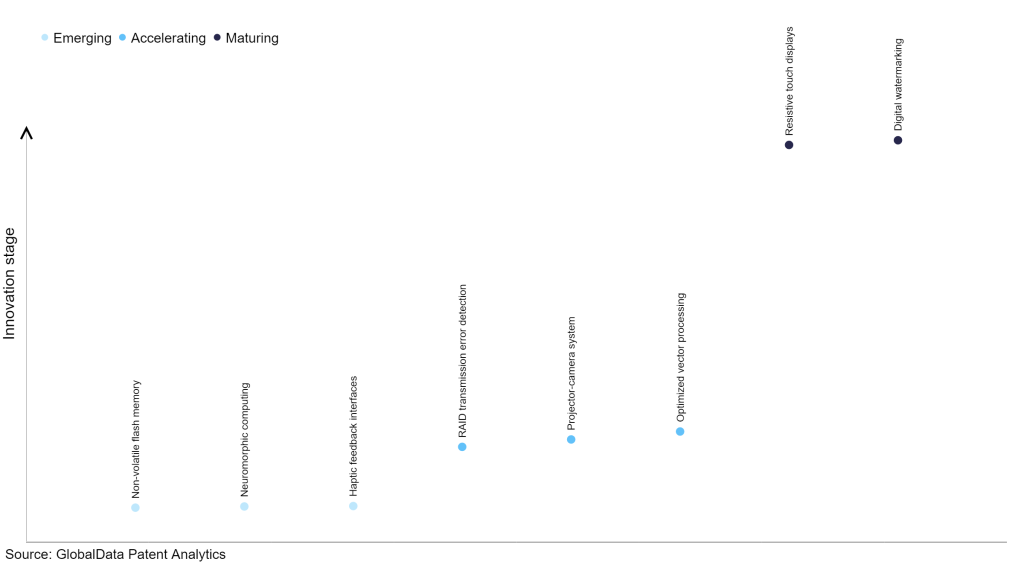The technology industry continues to be a hotbed of patent innovation. Activity is driven by the rising demand for enhanced transparency, security, and efficiency in contract processes, increasing adoption of digital transformation initiatives across industries, and growing complexity of global business operations and the need for compliance with diverse regulatory frameworks. The growing importance of technologies such as blockchain, automation, and artificial intelligence, further amplify the market growth. In the last three years alone, there have been over 1.5 million patents filed and granted in the technology industry, according to GlobalData’s report on Innovation in technology: digital contract governance. Buy the report here.

Access deeper industry intelligence
Experience unmatched clarity with a single platform that combines unique data, AI, and human expertise.
However, not all innovations are equal and nor do they follow a constant upward trend. Instead, their evolution takes the form of an S-shaped curve that reflects their typical lifecycle from early emergence to accelerating adoption, before finally stabilizing and reaching maturity.
Identifying where a particular innovation is on this journey, especially those that are in the emerging and accelerating stages, is essential for understanding their current level of adoption and the likely future trajectory and impact they will have.
185+ innovations will shape the technology industry
According to GlobalData’s Technology Foresights, which plots the S-curve for the technology industry using innovation intensity models built on over 1.6 million patents, there are 185+ innovation areas that will shape the future of the industry.
Within the emerging innovation stage, non-volatile flash memory, neuromorphic computing, and haptic feedback interfaces are disruptive technologies that are in the early stages of application and should be tracked closely. RAID transmission error detection, projector-camera system, and optimized vector processing are some of the accelerating innovation areas, where adoption has been steadily increasing. Among maturing innovation areas are resistive touch displays and digital watermarking, which are now well established in the industry.
Innovation S-curve for the technology industry

Digital contract governance is a key innovation area in technology
Digital contract governance involves utilizing blockchain technology for the creation, execution, and enforcement of smart contracts in a secure and decentralized manner. Smart contracts, coded to automatically enact the terms of an agreement when specific predefined conditions are met, are the centerpiece. By harnessing blockchain, this approach amplifies transparency, immutability, and security, removing the necessity for intermediaries and instilling confidence in the contract execution process.
GlobalData’s analysis also uncovers the companies at the forefront of each innovation area and assesses the potential reach and impact of their patenting activity across different applications and geographies. According to GlobalData, there are 675+ companies, spanning technology vendors, established technology companies, and up-and-coming start-ups engaged in the development and application of digital contract governance.
Key players in digital contract governance – a disruptive innovation in the technology industry
‘Application diversity’ measures the number of applications identified for each patent. It broadly splits companies into either ‘niche’ or ‘diversified’ innovators.
‘Geographic reach’ refers to the number of countries each patent is registered in. It reflects the breadth of geographic application intended, ranging from ‘global’ to ‘local’.
Among the companies innovating in digital contract governance, Alibaba Group is one of the leading patents filers. The company’s patents are aimed at developing techniques, systems, and devices, encompassing computer code stored on media, for modifying information within a blockchain. One of these techniques involves receiving requests to modify multiple data elements within one or more blockchains and effecting the changes accordingly. The other prominent patent filers in the space include nChain and Advanced New Technologies.
In terms of application diversity, nChain leads the pack, while Alibaba Group and Advanced New Technologies stood in second and third positions, respectively. By means of geographic reach, BASF held the top position, followed by Fortive and nChain.
Digital contract governance ensures secure, transparent, and efficient handling of agreements, reducing the risk of errors and disputes. Moreover, it enables remote collaboration, streamlines compliance with regulatory frameworks, and enhances overall trust in contract processes. By eliminating intermediaries and introducing decentralized, self-executing smart contracts, digital contract governance optimizes efficiency, reduces costs, and paves the way for a more agile and competitive business environment.
To further understand the key themes and technologies disrupting the technology industry, access GlobalData’s latest thematic research report on Technology.
Data Insights
From

The gold standard of business intelligence.
Blending expert knowledge with cutting-edge technology, GlobalData’s unrivalled proprietary data will enable you to decode what’s happening in your market. You can make better informed decisions and gain a future-proof advantage over your competitors.







